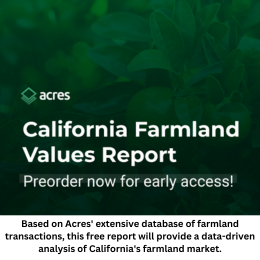September 1, 2020
By Michelle Pelletier Marshall, Global AgInvesting Media
There’s no arguing the fact that the discussion of trade is key right now in agriculture. With the replacement of NAFTA with the United States-Mexico-Canada Agreement (USMCA), which just went into effect last month, and the microscopic lens on the details of the Phase 1 trade agreement between the U.S. and China, there is much in flux. This brings with it opportunities and challenges in a sector rocked by a pandemic that has exposed the vulnerability of its very essence in feeding the world: the supply chain.
Multiple organizations and corporations throughout the sector have risen to this challenge to bridge the gaps and quickly create formidable solutions, many with a focus on technology such as Apeel Sciences, The Better Meat Company, and iFarm. For a look at some of the details of ag trade and the multitude of facts and stats involved, Global AgInvesting (GAI) welcomed Gregg Doud, chief agricultural negotiator at the Office of the United States Trade Representative, to its 12th annual Global AgInvesting (GAI) conference last week, its flagship event usually held in New York City, but virtually this year.
For those who joined us at the event, we say thank you and we’ll see you again (in-person we hope) very soon. For those who could not “be” there, here are some facts from Ambassador Doud’s high-energy presentation:
In 2002, it was predicted that the U.S. would ship between 9 and 18 million metric tons of soybeans to China; today, that number is up to 99 million metric tons.
Current U.S. ag exports total $141 billion.
The U.S. ag trade deficit with Mexico today is $11 billion, mostly because of imports of fruits and vegetables and distilled spirits.
The trade deficit with the EU is $18 billion.
Thanks to structural changes that came about in negotiating Phase 1 with China, the U.S. now has over 3,500 facilities (up from 1,500) that are eligible to export to China.
The negotiating of the Phase 1 agreement, which took place in 2019, was done over 33 meetings that were at least four hours long each.
Forty-eight percent of U.S. ag exports have gone to China in the last five weeks.
The U.S. now exports 25 percent of its pork.
Due to African swine fever, which hit China hard and caused an estimated loss of 30 to 40 percent of its hogs, the country now imports $2.2 billion worth of meat each month.
Historically, Japan has been the largest market for U.S. exported meat at $1 billion a month.
“This administration, since I’ve been in this job in 2 ½ years, has overhauled our trading relationships with Canada, Mexico, Japan, and China – new deals all the way around – those four countries are 47 percent of our ag exports,” said Ambassador Doud. “The USMCA is the gold standard going forward in how we are going to trade.”
On the Horizon
What’s the next big wave to justify investment in agriculture and agricultural land? To me, that discussion begins with the use of technology,” said Ambassador Doud, a sentiment that ran strong throughout many speakers’ presentations at GAI, such as the discussion on Future Outlook for Investments in Innovation or the presentation on Hitting the Curves with Controlled Environment Agriculture, or the panel on Establishing Universally Followed Standards for Measuring Sustainability in Agriculture.
“From this Kansas farm boy’s perspective, we don’t farm the same way we did in the 1980s and we sure don’t farm the same way we did when I bought that farm in 1998. I have a lot of ag economist friends who use econometric models to decide where we are going in the future by looking in the past,” said Ambassador Doud in ending his presentation. “The problem with econometric modeling is that it says that all other things are held as constant. That’s the great challenge in trade today is that we make assumptions based on everything being held constant when that is NEVER the case. We have to adjust our understanding of how trade works and how trade policy and negotiations work in the real world.”
To hear more from GAI speakers, visit gai-nyc.com where even though the live event has ended, one can still register to listen to the recorded sessions and partake in networking until September 30.
~ Michelle Pelletier Marshall is managing editor for HighQuest Group’s Global AgInvesting’s GAI Gazette magazine and its WIA Today blog, as well as a contributor to GAI News and the Oilseed & Grain News. She can be reached at mmarshall@highquestgroup.com.

Let GAI News inform your engagement in the agriculture sector.
GAI News provides crucial and timely news and insight to help you stay ahead of critical agricultural trends through free delivery of two weekly newsletters, Ag Investing Weekly and AgTech Intel.




